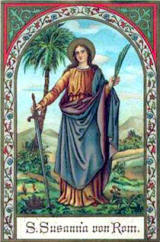
Aug. 11th, Saints Tiburtius and Susanna, Virgin and Martyrs.
This Tiburtius is celebrated in the inscription which Pope Saint Damasus placed at the traditional site of his death and burial, which same is usually set as the year 288, on the Lavican Way, to wit : when the sword of persecution pierced the bosom of our Mother the church, this noble Martyr, despising the command of the temporal prince, blissfully followed Christ to the heavenly kingdom ; which that merited for thee, O gracious Martyr, beloved of God, the honours of the sacred liturgy, and undying praise. And old story hath it that he was converted to Christianity by the soldier Sebastian, and for his boldness in proclaiming Christ was smitten with the sword at the Third Milestone on the Lavican Road, where he was buried by the Christians. On the same day is commemorated the noble maiden Susanna who, according to the Martyrology of saint Jerome, was beheaded for Christ about the year 295. The story told of her in later days was that she refused the offer of marriage of Galerius Maximianus, son to the Emperor Diocletian, because she had made a vow of her virginity to God, and after divers torments wherewith her holy resolution was tried, was smitten with the sword, in her own house, by order of the Emperor, and so passed to heaven to receive the double reward of virginity and martyrdom.
Collect:
O Lord, whomever failest to look down in mercy on them on whom thou bestowest the succour of thy Saints : grant, we pray thee, that the intercession of thy holy Martyrs, Tiburtius and Susanna, may evermore avail to comfort and defend us, through Jesus Christ our Lord. 

